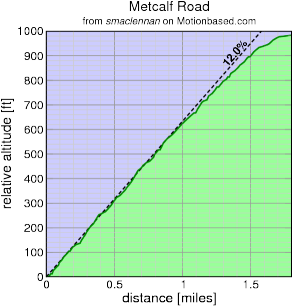Low-Key running
 |
I started a bit ahead of Gary. We skipped the brief "promenade" section, moving ahead to where coordinator Gary Griffin would honk the horn to indicate the start. The rules of Low-Key are the rules of the vehicle code, which means bikes ride to the right, but of course runners are not thus constrained. So we each set off on the left side of the road, I starting a bit ahead. Unfortunately, I retained my lead ahead of Gary for at best 10 seconds, before he came by with an incredible speed differential, leaving me smiling to myself that such a pace on this hill was possible. Soon he was gone, the next time I'd see him was at the finish-line food, where he told me he's run a 7:36/mile pace up the hill. That's just amazing: a 3:19 marathon pace.
 |
Stephen Fong photo |
Not long after the start I realized I'd forgotten to start my watch. This was just as well: it kept me in the moment. It's easy to do on Metcalf; the road rises steady, steeply, curve after curve.
I have to admit it was fun following riders up the hill. I managed to pass a few, but more whom I followed were able to pull away.
 |
Stephen Fong photo |
The 200 yard sign appeared. I opened my stride, kept the focus on relaxation, and tried to lengthen my stride more. The finish! I gave my number to the fantastic volunteers, and went to get some liquid after the unseasonably hot climb. I recovered quickly: I felt as if I could do it again. A good sign: I was adapting to running, clearly! Not that long ago I'd have been incapacitated for days. But also a bad sign. I clearly hadn't been able to push myself hard enough. But that's not a bad thing: it indicates room for improvement!
Later, I ran back down to the start. This wasn't bad at all: I felt relaxed, loose. The descent was fun, even if I ran slowly. When I arrived at the bottom, I fetched my bicycle off Greg McQuaid's roof-rack, and redid the climb. 12:02 of embracing the pain and I was back at the top. Ah! Much better. Running is fun, a wonderful diversion, a novel experience, but cycling is where my heart is.

Comments